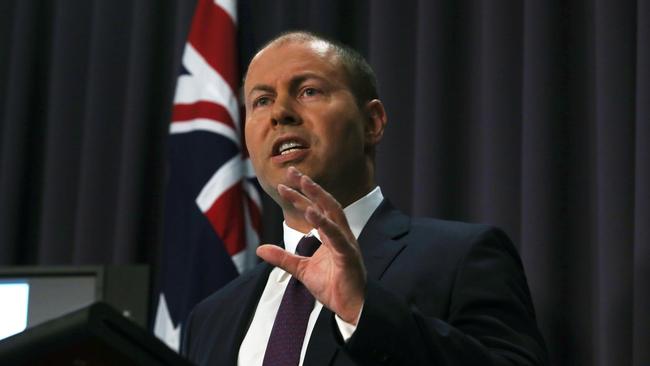Australia posts GDP growth of 0.2pc for the December quarter
Josh Frydenberg blames a sharp slowdown in growth on drought and housing, as Labor condemns a “quarter of failure”.

Australia’s economy slowed sharply in the second half of 2018, confounding an optimistic message from the country’s central bank and stoking the case for interest-rate cuts before the end of the year.
Gross domestic product grew by 0.2 per cent in the fourth quarter from the previous three months and by 2.3 per cent from a year earlier, the Australian Bureau of Statistics said.
The Australian dollar sank from US70.88 to a two-month low of US70.52 following the release of the figures.
JPMorgan later added to growing forecasts of rate reductions this year, with economist Sally Auld predicting the Reserve Bank will cut first in July and again in August.
While Treasurer Josh Frydenberg said the economy is in fundamentally good shape, the soft result follows growth of just 0.3 per cent in the third quarter, marking the weakest consecutive quarters of expansion since the RBA last cut interest rates in mid-2016.
Construction fell sharply in the fourth quarter, in line with a downturn in the housing market, while agriculture also declined as a widespread drought hurt grain production.

A slowdown in consumer spending and weakness in net exports have also put a brake on the economy.
“Growth in the economy was subdued, reflecting soft household spending and a decline in dwelling investment,” ABS chief economist Bruce Hockman said. “The approvals for dwelling construction indicate that the decline in dwelling investment will continue.”
The economic slowdown has stumped the RBA, which has been highlighting robust growth in the labour market, where hiring has continued, while the unemployment rate has remained low.
The Treasurer said drought, lower mining investment and a downturn in the house building industry were behind today’s weak GDP growth figures.
However Mr Frydenberg said the low quarterly growth was “well within market expectations”, as he tried to highlight the positives of today’s national accounts.
“This does represent some moderation in growth on the back of strong results that were observed in the first-half of 2018,” he told reporters in Canberra.
“The moderation in part reflects the impact of the drought, lower mining investment and as we continue to move from the construction to the production phase, as well as a decline in residential construction activity from record levels.”
Mr Frydenberg refused to speculate on whether the growth figures meant the RBA would have to deliver a pre-election interest rate cut.
“The issue of monetary policy is one for the Reserve Bank Governor and he has spoken numerous times about that,” he said. “The fundamentals are in good shape ... it is stronger than what we’re seeing from any G7 country.”
However in a note, JPMorgan said it now expects 50 basis points of easing in the third quarter.
“Today’s data suggest that the economy slowed sharply in 2H18. This is significant because it lowers the starting point for the RBA’s growth forecasts, and implies that 2019 growth will be marked lower in the May Statement on Monetary Policy,” said JPMorgan economist sally Auld.
Asked about analysts’ assertions Australia had entered a “per capita” recession, Mr Frydenberg said: “We’re not heading for that.”
The Treasurer later took to Twitter to say per capita negative quarters had occurred under John Howard, Kevin Rudd and Julia Gillard, who all oversaw periods of economic growth.
“Worth remembering that in 2000 & 2006 the Howard Govt had consecutive quarters of negative GDP per capita growth & Rudd & Gillard had 5 negative quarters,” Mr Frydenberg tweeted.
“Better indicator of living standards is real net national disposable income per capita which is above its 20 yr average.”
Worth remembering that in 2000 & 2006 the Howard Govt had consecutive quarters of negative GDP per capita growth & Rudd & Gillard had 5 negative quarters.
— Josh Frydenberg (@JoshFrydenberg) March 6, 2019
Better indicator of living standards is real net national disposable income per capita which is above its 20 yr average.
Opposition treasury spokesman Chris Bowen labelled the national accounts a “quarter of failure”.
“This is a damning indictment of the economic stewardship of Scott Morrison and Josh Frydenberg,” he said in Brisbane. “ Growth has slowed from an already weak quarter, last quarter.
“What we are seeing is wages are not growing fast enough. Productivity, we have now had 8 quarters of negative productivity growth. What we see is that profits continue to grow but wages simply do not.
“The fact of the matter is that this is an “F” result on the economic management of Scott Morrison and Josh Frydenberg. Australia can do better.”

In a morning speech ahead of the release of the GDP data, RBA Governor Philip Lowe said there was growing tension between weakening output in the economy and evidence that the jobs market is still strong. He hopes that will resolve itself soon.
“We have the flexibility to adjust monetary policy in either direction as required...At the moment, the probabilities appear reasonably evenly balanced,” Dr Lowe said in a speech to a business Summit.
NAB market economist Kaixin Owyong said the chances of a Reserve Bank rate cut had increased with the data - especially if the labour market falters - but that she still forecasts no change in the foreseeable future.
The RBA has held interest rates at a record-low 1.50 per cent since mid-2016, hoping crossed for a rise in wages, and inflation, which has so far been elusive.
“For the RBA, the data makes its forecast of three per cent growth over 2019 look increasingly unlikely, as growth would need to accelerate markedly from its current rate,” she said.
“We believe the (Reserve) Bank will be increasingly uncomfortable with the ‘growing tension between strong labour market dataand softer GDP data’ as the weakness in household spending appears to be more persistent than it forecast.”
Weak consumer spending and falling house prices top the list of concerns for the economy, with trade tensions and a slowdown in China’s economy also weighing on confidence.
House prices have been falling since mid-2017, with the major state capitals of Sydney and Melbourne leading the retreat.
Some forecasters expect the peak-to-trough fall in Sydney house prices to be close to 20 per cent, if not more.
Dow Jones Newswires, AAP





To join the conversation, please log in. Don't have an account? Register
Join the conversation, you are commenting as Logout